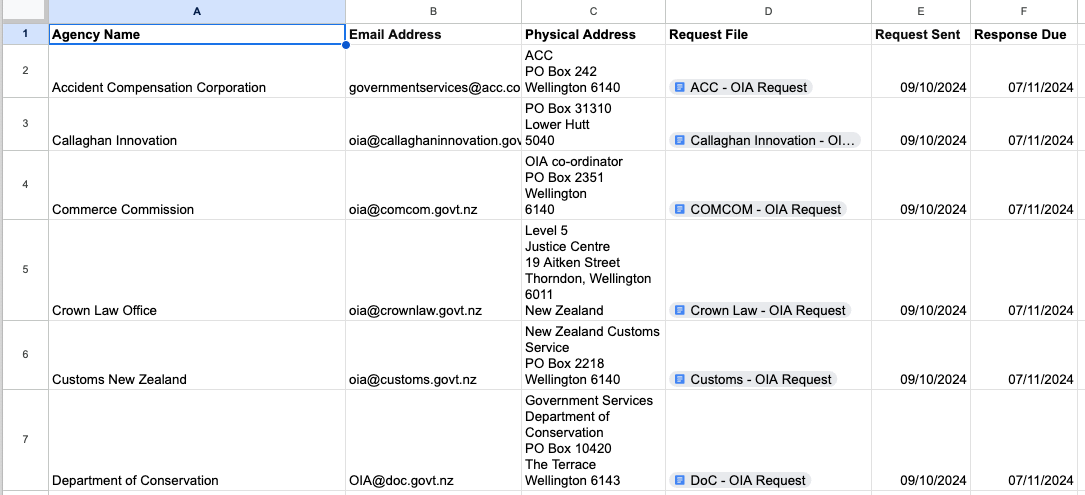This week’s article was written by dear friends of Bullshit Hunting, Mark & Vanessa Piper of Distant Field Labs. Follow Distant Field Labs on LinkedIn and visit their website for more compelling content.
Distant Field Labs is an Open Source Intelligence Hub and passion project—a platform to explore ideas and technologies, to get concepts out there in the public domain, and to give a little back.
When dissecting an issue via media coverage, it can be nearly impossible to actually work out what’s going on. It’s not that journalists are bad at their jobs, it’s that they often don’t get the time to investigate thoroughly.
As we watched the newly appointed coalition government here in New Zealand swoop into power and execute on their promises to slash jobs across the public sector, we were increasingly confused. Not only were we bewildered at the ad-hoc and populist approach to slashing job numbers like a 1980s Wall Street enterprise, we couldn’t find any indication as to what the actual lay-off numbers looked like.
We kept an eye on local news outlets and the PSA for statements regarding numbers, agencies affected, and so on, but no accurate-looking number was forthcoming. There were dozens of media articles, conflicting numbers, and ad hoc statements, and most interestingly, even the unions themselves weren't publishing clear numbers on how many New Zealand public servants had been affected.
How many jobs are gone? How many more to go? Is this fear-mongering? Is it real?
To support some research, we wanted to know.
For the remainder of this post, we will run through our experience executing the democratic process to obtain information under Aotearoa's Official Information Act.
Open Government Goodness
One of the truly great things in a democratic society is that we are all allowed to access government information.
In New Zealand, the mechanism by which we can request information from our government is via the Official Information Act of 1982 (we’ll stick with OIA for short). Similar to the “Access to Information Act” in Canada or “The Freedom of Information Act” (FOIA) in the UK and America, it lets citizens file a request to the government for specific information. If the government holds it, and it won’t violate privacy rights or national security, they will respond with the requested information. It’s an amazing mechanism that helps ensure power is not abused unchecked.
And so, this is where we begin.
Once we realise the existence of official information acts, many of us crack our knuckles and enthusiastically fire off a bundle of pointy requests—which is our democratic right, after all. However, this comes with a few problems.
If you’re new to information requests, this process is made easy for the most part, as portals exist to help citizens request information. For example, here in New Zealand, you can use FYI.org.nz. In Australia, Right To Know. The UK has WhatDoTheyKnow, and America has NFOIC, FOIA and MuckRock sites to help your requesting process. Alaveteli, software designed to assist with portal access and creation, maintains a list across jurisdictions here.
There’s a ‘gotcha!’ here, however. The government has its own language. It has its own way of scoping requests, and its own way to interpret specific words. It isn’t malicious, it’s simply that bureaucrats understand that words carry meaning and that meaning can significantly change the nature and effort associated with certain actions. They consider specific wording very carefully and have internal cultural norms that we don’t use much outside of government.
For this project we wanted to make sure our requests landed in the right place, in a respectful manner. As we have ascertained from prior experience, the best way to do this is with a letterhead. The OIA requires requests to be submitted from within New Zealand and by New Zealand residents. So our letter clearly states our name, the organisation we represented, our physical address in NZ, and a snazzy signature.
We then cited the Act we were respectfully requesting the information under, a space for our questions and a very specific acknowledgement with regards to privacy aspects of the Act. We didn’t want some incidental sending of government employee information or any other nasty mishaps.
Finally, we took the time to sincerely thank them in advance for their time processing the request, and our contact details. If we could (respectfully) provide any further clarification or scope.
We were fucking professionals.
A Question of Questions
Next, we had the very real and pressing question of what to ask for.
We have this new Prime Minister, using firm CEO language and slashing jobs. What do these changes look like? How broad are they? Are there risks of discrimination? This is what we wanted to know.
First, we decided to set a specific scope for our timeframe. We needed a before and after to conduct comparisons with the data.
The newly-appointed government took their place in November 2023 after the election. Most of the reporting on the cuts began in earnest in April 2024, and we started this work in late September 2024. To ensure we were not burdening government employees, we decided a calendar year from September 2023 through September 2024 should provide adequate coverage of either side of the government being appointed.
Next, who has been affected?
Like all enterprises, government agencies are made up of part-time, full-time, and contractor employees. For our quest, we decided to, once again, keep it as simple as possible for government employees to respond to our requests. Generating a complex demographic breakdown was going to be problematic for those in already stretched positions, and we were well aware that the government was acting like an asshole on that one already.
We decided it would be useful to understand the demographic makeup of gender for full-time employees within the government.
This means those identifying as Female, Non-Binary, Male or opting not to disclose at all. The decision for this scope obviously caps us on understanding if any discrimination has occurred against race (such as Māori, Pacific Peoples or Asian), but we really wanted to keep it as simple as possible. We wanted an indicator—more accurate than public reporting, not burdensome on the public servants responding to our requests.
Finally, (admittedly as an afterthought) we had a long-standing curiosity around neuro-spiciness. How many of the agencies are tracking the neurodivergence of their workforce?
With the questions outlined, we threw them into our template as two discrete questions:
Total number of full time employees:
As of 30 September 2023?
As of 30 September 2024?
Demographic breakdown of full time employees for each date above:
Number identifying as Female?
Number identifying as Non-Binary?
Number identifying as Male?
Number who prefer not to say? Number who identify as Neurodivergent?
Searching for Scale
With the newly minted questions at hand and our template done, we hit one of the harder questions. Which agencies do we ask?
We had to ignore the urge to say “all of them” because that would be a significant waste of time for both the government and us. We’re not in the government auditing business, we just had some very real questions and wanted to get a sense of scale and impact.
Once again, the PSA failed to provide the insights we needed (which is still odd, but a thread for another day), and in the end, we picked a random news article with what appeared to be a list of agencies being heavily affected by the job cuts. It was a good mix of size and purpose. Everything from the Accident Compensation Corporation (4000+ staff) through to the Ministry for Ethnic Communities (approximately 75 staff).
For each agency, we pulled together the list of details we’d need to successfully file a request with our letter template.
The agency name, the OIA email address and the physical location of the agency were all gathered. We then populated the templates, created PDFs for each, and leveraged Gmail templates to fire them out the door while recording them in a basic tracker.
For reference, when we say basic, the initial tracker looks like this:
Off our letters went. Into the wild, awaiting responses.
Words Matter
We carefully considered our words in both the overall letter content and the questions themselves. We are still learning and expected to get some clarification questions.
Several lessons we learnt as we worked through responses and clarification questions with agencies over the following weeks include the following:
We were happy to see that, for the most part, the government cares about diversity. They do not, however, use the nomenclature “non-binary.” Instead, the preferred term is “Another Gender.” Several agencies requested clarification on this which we sincerely appreciated.
In retrospect, we wondered if we could have figured this out before sending the requests. Unfortunately, throughout all public-facing guidance and documentation we could find, they do indeed use the term “non-binary.” We could, however, have defined what we meant by “non-binary” to reduce confusion.
The lesson here is if there’s room for doubt, define your terminology upfront. It costs nothing and saves time.The term “full-time” resulted in a mix of interpretations when it comes to People and Culture teams across agencies. Many agencies have the total head account (that is full-time equivalent employees) and then the number of actual full-time equivalents. Many roles across these organisations are handled by part-time staff working to make up the equivalent of a full-time employee.
We kind of knew this going into the project; however, we made a basic assumption with regard to how we phrased the questions.Similarly to our first lesson, we could have been more upfront in our determination of what “full-time” means.We could have clarified/requested a more appropriate output format for our work. By not providing a desired format, data came in by default in PDF/letter form.
Given the information we were asking about being very limited, this was a bit finicky but ultimately no big deal. We could populate our results sheet as we updated our tracker and process the data after the responses have come in.
However, if we were requesting more complex or detailed data, requesting in something like a CSV format would have saved significant time and effort. In general, you do have a right to request the data in an accessible format for your purposes.
Catching Responses
Twenty-five requests meant that (in theory, at least) we had 25 responses incoming. In most jurisdictions, there’s an expectation that acknowledgement of the request lodgement will occur, followed by the actual response within the legislated timeframe. In New Zealand, that’s 20 working days.
As the acknowledgements came in, we extended our tracker with a new column. Then, as the responses came in (relatively quickly), we extended with yet another two columns. The response date and the response letter.
This meant that we could ensure that the responses were marked as received as they came in and help ensure a process by which we ensured we thanked the ministerial teams for their effort.
Spend enough time looking at publicised OIA or FOIA requests and responses, and you quickly get a sense that people assume public servants are there to be abused. Subject to request demands. Not human beings on the other side of the email. So, ensuring each and every team member was thanked was a non-negotiable action for us.
One great example of this was Callaghan Innovation. We hadn't seen a response from them after some time, and as we were preparing to send follow-up inquiries, we got this email:
On a long enough timeline, IT issues happen to everyone. No harm, no foul. They owned it and they delivered the response shortly after.
We’d like to think the same for the Department of Corrections:
Did we have the right address? Was it received? Rather than assume malice, we need to assume a failure of process. As of right now, we’re not sure, but we will continue to follow up to understand.
Processing the Results
This is about process without a focus on the results. However, we wanted to take the time to share the headlines from our work in case it is of use to others.
We asked 25 agencies, and had responses from 24 of them. 2 requested extensions under the act. The requested agencies included:
Accident Compensation Corporation
Callaghan Innovation
Commerce Commission
Crown Law Office
Customs New Zealand
Department of Conservation
Department of Corrections
Department of Internal Affairs
Kāinga Ora
Ministry for Culture & Heritage
Ministry for Ethnic Communities
Ministry for Pacific Peoples
Ministry for Primary Industries
Ministry for the Environment
Ministry of Business, Innovation & Emp
Ministry of Education
Ministry of Health
Ministry of Social Development
Niwa
NZQA
Oranga Tamariki
Statistics New Zealand
Tertiary Education Commission
The Treasury
Worksafe
Cross the agencies queried, the overall change in full-time employees across them was a reduction of 5.75%.
Of that percentage, there was a fairly even distribution of roles affected for all demographics (female, non-binary, male).
While the results of this process are still unfolding, they will be shared in the future—so continue checking back or subscribe to stay updated. In the meantime, we hope this piece encourages you to reflect on your own approach to OIA or FOIA requests. Consider how you can refine your process to make it more effective while remembering the humanity of those on the other side of these interactions. Together, we can foster better communication and transparency to fairly understand the world we live in.
References:
https://thespinoff.co.nz/politics/18-04-2024/a-running-tally-of-the-public-sector-job-cuts
Written by dear friends of Bullshit Hunting, Mark & Vanessa Piper of Distant Field Labs. Follow Distant Field Labs on LinkedIn and visit their website for more compelling content.
Distant Field Labs is an Open Source Intelligence Hub and passion project—a platform to explore ideas and technologies, to get concepts out there in the public domain, and to give a little back.









